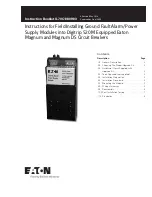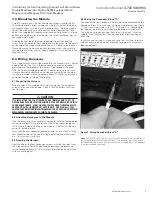
7
Instruction Booklet
IL70C1080H03
Effective May 2014
Instructions for Field Installing Ground Fault Alarm/Power
Supply Modules into Digitrip 520M Equipped Eaton
Magnum and Magnum DS Circuit Breakers
EATON www.eaton.com
10.0 Post Installation Testing
10.1 When to Test
Testing prior to start-up can best be accomplished with the breaker
out of its cell or in the Test, Disconnected, or Withdrawn (or
Removed) cell positions.
CAUTION
TESTING A CIRCUIT BREAKER WHILE IT IS IN SERVICE AND CARRYING
LOAD CURRENT IS NOT RECOMMENDED.
TESTING OF A CIRCUIT BREAKER THAT RESULTS IN THE TRIPPING OF THE
CIRCUIT BREAKER SHOULD BE DONE ONLY WITH THE CIRCUIT BREAKER
IN THE TEST OR DISCONNECTED CELL POSITIONS OR WHILE THE CIRCUIT
BREAKER IS ON A TEST BENCH.
CAUTION
ANY TRIPPING OPERATION WILL CAUSE DISRUPTION OF SERVICE
AND POSSIBLE PERSONAL INJURY, RESULTING IN THE UNNECESSARY
SWITCHING OF CONNECTED EQUIPMENT.
10.2 Code Requirements
The NEC, under Article 230-95-C, requires that any ground fault pro-
tection system be performance tested when first installed. Conduct
tests in accordance with the approved instructions provided with the
equipment. Make a written record of this test and make the results
available to the authority having inspection jurisdiction.
10.3 Standard Requirements
As a follow-up to the basic performance requirements stipulated
by the NEC, UL Standard No. 1053 requires that certain minimum
instructions must accompany each ground fault protection system.
These statements (Section 5.4.3), detailed testing information, plus
a copy of the record forms can be found in the Instructional Leaflet
which came with your breaker. (I.L. 70C1037)
10.4 Test Methods - (Refer to Figure 2)
10.4.1 Power Up Check
Upon energizing the trip unit with the correct auxiliary power control
voltage onto secondary contacts A-14 and A-15, confirm that the sta-
tus LED and LCD display are functioning.
If the Digitrip does not have a ground element and the module was
installed just for the powering of the LED display, then perform an
overload test at 200% to verify tripping (secondary injection test
with a test kit). This would complete the verification sequence. If a
ground element is involved, continue with the following tests.
10.4.2 Secondary Injection Test
An AC current of 1 Amp input can be injected onto the breaker
secondary contacts B-4 and B-5. This will trigger the Ground Alarm
indicator to function and close contacts A-10 and A-11.
10.4.3 Primary Injection Test
A primary current higher than the Ground Current Pickup setting,
when applied to a pole of the circuit breaker, will trigger the Ground
Alarm indicator to function.
10.4.4 General Test Instructions For Secondary and Primary
I
njection Methods
The interconnected system must be evaluated only by qualified per-
sonnel and in accordance with the equipment assembler’s detailed
instructions.
To avoid improper operations following apparently correct simulated
test operations, the polarity of the neutral sensor connections (if
used) must agree with the equipment assembler’s detailed instruc-
tions. Where a question exists, consult the specifying engineer and/
or equipment assembler.
WARNING
DO NOT ATTEMPT TO INSTALL, TEST, OR PERFORM MAINTENANCE ON
EQUIPMENT WHILE IT IS ENERGIZED. DEATH OR SEVERE PERSONAL
INJURY CAN RESULT FROM CONTACT WITH ENERGIZED EQUIPMENT.
DE-ENERGIZE THE CIRCUIT AND DISCONNECT THE CIRCUIT BREAKER
BEFORE PERFORMING MAINTENANCE OR TESTS.
WARNING
PERSONAL INJURY CAN OCCUR WHEN WORKING ON POWER SYSTEMS.
ALWAYS TURN OFF POWER SUPPLYING BREAKER BEFORE CONDUCTING
TESTS. TEST OUT OF THE CELL, IF POSSIBLE. THERE IS A HAZARD OF
ELECTRICAL SHOCK OR BURN WHENEVER WORKING IN OR AROUND
ELECTRICAL EQUIPMENT.
Verify the grounding points of the system using high voltage testers
and resistance bridges to ensure that ground paths do not exist that
could bypass the sensors.
Use a low-voltage (0 to 24 volt), high-current, AC source to apply a
test current of 125% of the Digitrip unit ground fault pickup setting
through one phase of the circuit breaker. This should cause the
breaker to trip (on LSIG style trip units) in less than 1 second and
operate the alarm indicator. Reset the breaker and the alarm indica-
tor. Repeat the test on the other two phases (see Figure 10).
Figure 10. Connection Details for Conducting Single Pole,
Single Phase Current Tests with the Breaker Removed from the
Cell.
Apply the same current as described above through one phase of
the breaker, returning through the neutral sensor if so equipped. The
breaker should not trip and the alarm indicator should not operate.
Repeat the test on the other two phases.




























